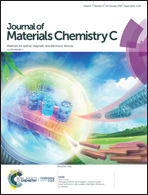Highly flexible chemical sensors based on polymer nanofiber field-effect transistors†
Abstract
Soft electronic devices are key components of flexible or wearable smart electronics. Chemical sensors based on organic field-effect transistors (OFETs) show great promise because of their high sensitivity, low cost, fast response, flexible applications, and signal amplification via gate voltage tuning. In addition, the sensor response can be made highly selective by incorporating specific functional groups or recognition elements. The response magnitude of an OFET sensor depends strongly on the surface area of the active layer that interacts with the analyte. In this study, two strategies including nanostructuring and surface functionalization have been explored to enhance the performance and sensitivity of OFET sensors. We describe the fabrication of highly flexible, electrospun poly(3,3-didodecylquaterthiophene)/calix[8]arene (PQT-12)/C[8]A sensors employing semiconducting polymer nanofibers (NFs) as the active layer. The resulting bendable and flexible PQT-12/C[8]A OFET sensors show high sensitivity to ethanol (192%) and toluene (229%) and moderate sensitivity to n-hexane (121%) with a minimum detectable level of 10 ppm. In addition, the PQT-12/C[8]A NF sensors are electrically stable under typical operating conditions with a bending radius down to 0.5 mm. This work demonstrates a viable approach for the fabrication of flexible OFETs for use as wearable sensors and health-monitoring devices.



 Please wait while we load your content...
Please wait while we load your content...